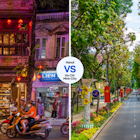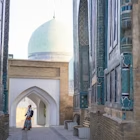
Long the dormitory town for the temples of Angkor, Siem Reap has emerged as a destination in its own right thanks to an alluring combination of world-class wining and dining, vibrant nightlife, stylish shopping, adrenaline-fuelled activities, other-worldly floating villages and a host of lifestyle experiences in the countryside beyond. Oh, and it might just help that the eighth wonder of the world – wonderful Angkor Wat – is just a few miles down the road.
Speaking of Angkor, this is one of those bucket list destinations that really does justify all the superlatives. The Mother of all temples, Angkor Wat draws visitors to Cambodia in droves, but the surrounding forest hides an incredible diversity of ancient temples, any one of which would be the envy of any country in Southeast Asia.
The enigmatic faces of the Bayon, the mercury-colored tree roots tangled around the ruins of Ta Prohm, the exquisite carvings of Banteay Srei and the Mayan-pyramid-like temple of Koh Ker – all are world-beaters when it comes to size, scale and symmetry.
While Angkor is the shop window to lure you in, and Siem Reap covers the key ingredients for your stay such as hip hostels and beautiful boutique hotels, the real icing on the cake is the Cambodian people. The warm welcome they provide is legendary, and their spirit will leave an indelible mark on your soul.

When should I go to Siem Reap?
This famous temple town is a year-round destination, but many visitors choose to come during the dry season from November to March. However, while the weather is good, this is also the busiest time and some of the iconic temples at Angkor can be overcrowded.
The wet season – also known as the "green season" – transforms the rural landscape of northwestern Cambodia into a palette of vivid greens, and the temples come alive with moss and lichen. There are also lots of deals on offer at the leading hotels in town.
Several important festivals see both locals and visitors flock to Siem Reap. The most lively event of the year is the Bon Om Tuk water festival in late October or November, which sees colorful boat races on the Siem Reap River. Chaul Chnam Thmey – the Khmer New Year – in mid-April is the biggest date on the festival calendar, and there are major celebrations in and around Siem Reap.
Other calendar highlights include the Angkor Wat Half Marathon in early December and the Giant Puppet Parade in February or March.

How much time should I spend in Siem Reap?
Many visitors opt to buy a three-day pass for the Temples of Angkor, staying in Siem Reap for three or four days while they explore. This is a great way to break up the temple viewing into bite-sized chunks and avoid the risk of getting "templed out." This timeframe will also allow time for some non-temple activities, such as a boat trip on Tonle Sap Lake, taking a cooking class in Siem Reap, or just hanging out by the pool.
When it comes to Angkor, most visitors prioritize the "Big Three" temples of Angkor Wat, the Bayon and Ta Prohm. However, if time allows, there are plenty more temples to explore that are the envy of Cambodia's neighbors.
To dive deeper into Angkor's story, consider a visit to Banteay Srei, Beng Mealea, Preah Khan, Koh Ker or the holy mountain of Phnom Kulen. If you want to see all the important temples and enjoy some of Siem Reap's best experiences and activities, then staying for a week is a wise move.
Is it easy to get into and around Siem Reap?
As a major transport hub, Siem Reap is well-connected with the rest of Cambodia and neighboring parts of Southeast Asia. About 44km from town, Siem Reap-Angkor International Airport (SAI) offers flights to Phnom Penh, Sihanoukville and several other Southeast Asian capitals, including Bangkok, Hanoi and Kuala Lumpur.
A taxi from the airport to the center of Siem Reap will cost US$35 or there's a regular shuttle bus for US$8. It's also possible to travel by bus to Phnom Penh and Battambang, and to Bangkok via the international border crossing at Poipet.
Siem Reap is a small town at heart and the old center is easily walkable. When it comes to exploring the temples of Angkor, the easiest option is to charter a vehicle with a driver; take your pick from tuk-tuks (from US$15), cars (from US$35) and minivans (from US$50). It's also possible to rent a mountain bike (from US$5) or motorbike (from US$10).

The top things to do in Siem Reap
With the incredible temples of Angkor on its doorstep, Siem Reap has become one of the most iconic destinations in Southeast Asia. But Siem Reap is so much more than its temples, with plenty of exciting activities on tap, including trips to floating villages on Tonle Sap Lake.
Explore the majestic temples of Angkor
The headline act in Cambodia, the temples of Angkor are the reason for Siem Reap’s existence, and seeing the sunrise at the world’s largest religious building, magnificent Angkor Wat, is a must, but allow several hours to explore this vast complex.
Be sure to investigate the weird and wonderful faces carved into the Bayon at the heart of Angkor Thom, and channel your inner Lara Croft at the "Tomb Raider" temple of Ta Prohm, a gorgeous ruin that is being slowly suffocated by tentacle-like tree roots.

Visit the sacred mountain of Phnom Kulen
Home to the ‘lost city’ of Mahendraparvata, Phnom Kulen was actually the first capital of the Angkor era. Dating back to 802 CE, this was the spot where King Jayavarman II proclaimed himself Devaraja (God King) of the Khmer Empire.
Most visitors come to see the iconic waterfall, the River of a Thousand Lingas and the reclining Buddha, all clustered together near the village of Preah Ang Thom. However, there's much more to see, including giant stone guardian animals at Sra Damrei, elaborate carvings at Peung Tbal and a smattering of ancient brick temples.
Enjoy some adrenaline adventures around Siem Reap
If you tire of temples and crave some more intense action, all sorts of activities are available around Siem Reap. The Angkor Zipline is a popular cable course near the Ta Nei temple and the surrounding forest is home to a resident family of gibbons.
Tours by quad bike (ATV) are very popular and it's possible to take a sunset ride to the ricefields on the edge of Siem Reap. There is also the Cambodia Wake Park on the outskirts of town, which offers wakeboarding and water-skiing for thrill-seekers.

Go bar-hopping in Boho and beyond
While Pub St has the famous name and party reputation, the volume is permanently turned up to 11, and the mellow bars of St 26 and Boho are arguably a better option for a night out in Siem Reap. Kick off with some local Cambodian flavors at the excellent Tevy’s Place or sample international bites at Mr Ciao (aka SO 26) also a great spot for weekend tunes.
Nearby, Miss Wong is a throwback to 1920s Shanghai and has some of the best cocktails in town. Laundry Bar is a late-night option with two pool tables, ambient EDM sounds and an open mic night on Wednesdays.
Take a boat ride on the Tonle Sap
The Tonle Sap is the largest lake in Southeast Asia and there are several floating villages and soaring stilt house communities close to Siem Reap, accessible on organized boat trips. The large floating village of Chong Kneas is the closest village to town but also the busiest with tour groups.
More atmospheric are the stilted villages of Kompong Pluk and Kompong Khleang. Alternatively, try some wet-season kayaking in the flooded forests of Me Chrey.

Go to the circus
The circus is always in town in Siem Reap thanks to the epic performances of Phare the Cambodian Circus. Performers and acrobats blend high-octane performances with insightful storytelling about the challenges of life in contemporary Cambodia. Phare holds the Guinness World Record for the longest uninterrupted circus performance – a show lasting 24 hours.
My favorite thing to do in Siem Reap
Exploring the temples of Angkor on two wheels is one of the most rewarding experiences in Siem Reap. A new cycle path runs from town out to the temples, winding through the forest. Completely separate from the busy road, it offers backdoor access to some of the best sights, including the North Gate of Ta Prohm. My favorite ride follows the walls of Angkor Thom from the East Gate to the South Gate, offering dramatic views over the vast moat.

Frequently asked questions
Here are some of the most commonly asked questions about visiting Siem Reap.
Do I need a visa?
Citizens of most countries can obtain a tourist visa on arrival at the airport in Siem Reap for US$30; citizens of ASEAN nations do not require a visa. It's also possible to get an e-visa in advance using the government's new e-arrival app, which offers a simple way to provide the required immigration, customs and health information.
Are there any etiquette rules for visiting Angkor?
The temples of Angkor represent the most sacred religious site in the Kingdom and visitors are asked to dress modestly. To visit the highest level of Angkor Wat, guests must cover their upper arms and legs; if you wear shorts, these should come down to the knees.
How much money do I need for Siem Reap?
Siem Reap scores highly on the VFM (value-for-money) index as a cheap place to explore. Budget accommodation is widely available and the infamous Pub St knocks out draft beer for US$1 a glass. Siem Reap also offers some of the best boutique hotels in the region, with rooms at enticing prices, and excellent Khmer restaurants and international eateries offer a delectable gastronomic experience at a less than astronomic price.
Debit and credit cards are widely accepted, although phone payment systems such as Apple Pay and Google Pay are not always available. In general, budget travelers can get by on about US$50 per day, mid-rangers will be looking at around US$100-150 per day, and top-end travelers will need upwards of US$250 per day.
Hostel room: US$5–15
Boutique hotel room: US$50–100
Temples of Angkor visitor pass: US$37/62/72 for 1/3/7 days
Tuk-Tuk for a day at Angkor: US$15–20
Mountain bike hire: US$5–10 per day
Bowl of kyteow (noodle soup): US$2–4
Upmarket dinner for two: US$30–50
Cup of espresso: US$2
Draft beer: US$0.50-2.50
Glass of wine: US$4–7
Explore related stories


 Tips & AdviceHanoi vs Ho Chi Minh City: which Vietnamese city has the edge?
Tips & AdviceHanoi vs Ho Chi Minh City: which Vietnamese city has the edge?Jan 8, 2025 • 7 min read


 Destination PracticalitiesHow to get your cell phone connected in Vietnam: eSIMs, wi-fi and mobile networks
Destination PracticalitiesHow to get your cell phone connected in Vietnam: eSIMs, wi-fi and mobile networksDec 25, 2024 • 9 min read













